At any given moment, any one of Buffer’s staff of nearly 30 could be on our social media accounts chatting with customers, answering questions or scheduling posts for the days or weeks ahead.
Thanks to Buffer’s social media management tools and the many other awesome tools that help us out, social media is a team effort here. Maybe it’s the same where you are?
We’ve talked about how one person can handle multiple social media accounts on the blog, and now it’s time for the other side of the coin: Working as a team. If you’ve ever been a member of a social media team or had multiple people collaborating on your social media account, you might agree that there is great power and great responsibility in such a setup.
Whether you’re a team of two posting for a small brand on Twitter or a team of dozens working on the overall marketing for a large company, some things need to be handled quite differently when it comes to teams.
In this post, we’ll examine some of the best tools, resources and strategies we’ve found for keeping everyone on the same page as you work together on a social media team.
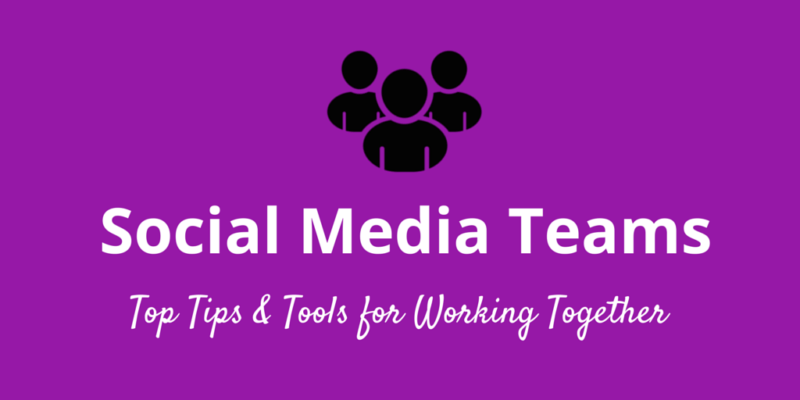
Determine your strategy and structure
A survey by Altimeter discovered that the average number of people on a full-time social media team at a large (<1000 employees) company is 11 professionals, working together in an organization chart that looks a bit like this:
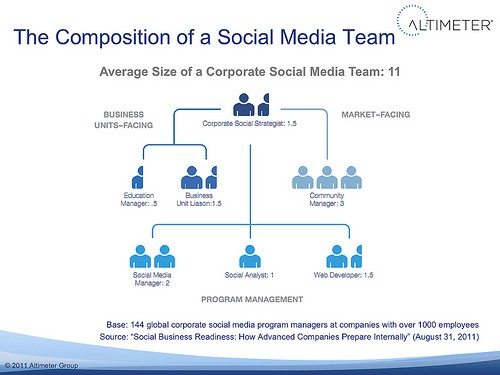
Depending how strictly regulated your industry is, this structure could also include occasional oversight from human resources, legal departments and lots more.
On a smaller team, maybe your organization looks more like this chart from Chief Marketer:
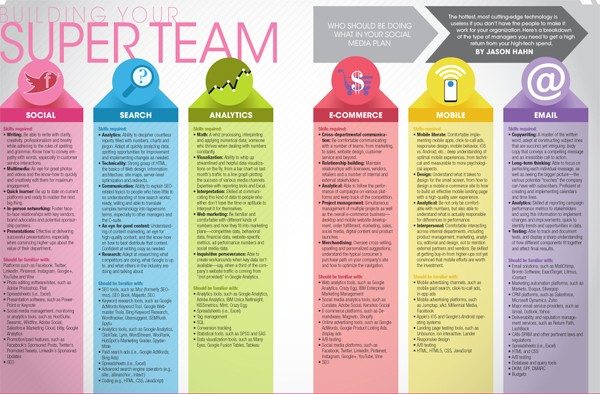
How do you keep everyone on the same page and in the loop? Creating a social media strategy everyone can agree on and reference easily is a great first step. This document might discuss your objectives for social media, your day-to-day process and your measurement goals, as represented in this neat framework from Advanced Human Technologies.
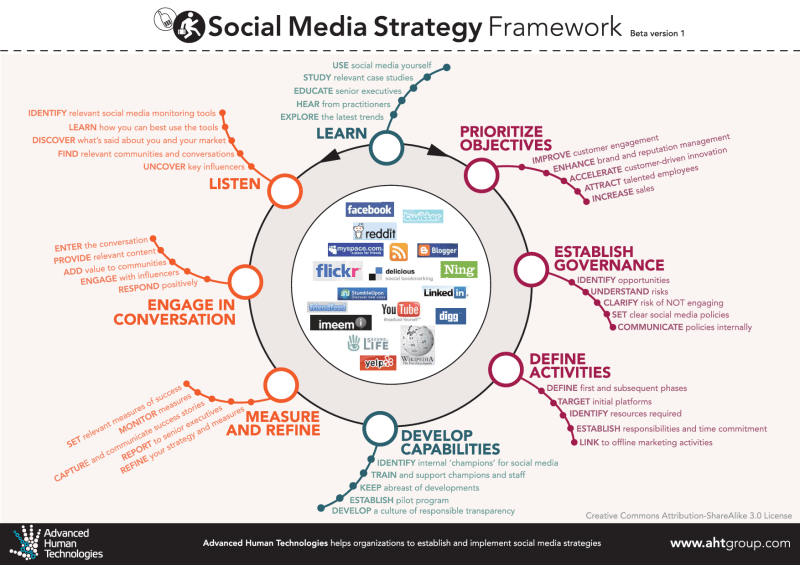
I really like Lisa Barone’s guide to creating a social media plan to help you through each of these steps.
Establish a consistent voice and tone
When multiple people are representing your brand and speaking in its voice, it helps to first make sure everyone knows what that voice sounds like. What’s your personality? What do you stand for? What is your purpose?
Establishing a strong and consistent voice and tone seem to be the keys to getting everyone on the same page here. At Buffer, we have a tone guide that is our North Star for talking with customers. It, in turn, is quite inspired by Mailchimp’s voice and tone guide.
Interested in coming up with your own? There are a few exercises we describe in our guide to finding your social media voice, namely this one:
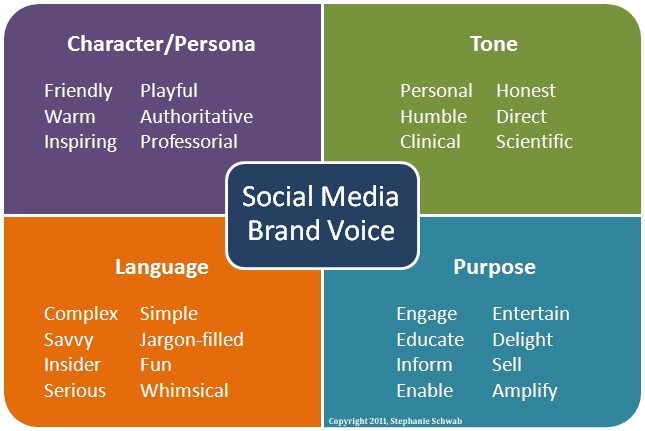
- Character / persona – Who does your brand sound like? If you picture your social brand as a person (a character), here is where you can flesh out this identity with specific attributes that fit who you want to sound like online.
- Tone – What is the general vibe of your brand?
- Language – What kind of words do you use in your social media conversations?
- Purpose – Why are you on social media in the first place?
Together, these four areas can help define the overall voice of your brand. It’s a helpful exercise to go through these steps to gain insight into each area.
Know how, where, and what you’ll post
It helps a great deal to chat with team members about which social networks are right for you, what categories and and types of content you’re going to post about, when and how often.
Will you focus on your specific niche only, or might you expand into more topics? Will you share only your content, or grow your thought leadership reputation by sharing a ratio of your content and great stuff by others?
Getting a focused view on these concepts helps to present your community with a consistent experience, but remember that your experiences here can evolve over time. Buffer started out by posting almost exclusively on Twitter tips and tools, and today we share from a diverse well of topics including social media, productivity, self-improvement, workplace culture and more.
Let your audience know who is posting
One big way to create a better feeling for the people you’re talking with on social media is to make sure they know that there are real humans behind that corporate social media account.
Particularly when you’re responding to questions or comments, it can be handy to identify who is posting. This immediately gives your replies a friendlier face and gives others the chance to engage with you as a person instead of just as a logo.
One popular method is to sign tweets with a carat (^) and your initials. Here, Southwest showcases that strategy:
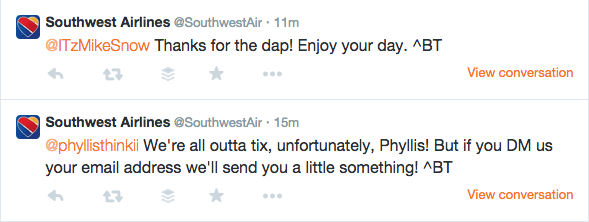
This is a fairly understood convention by now, but there are lots of new people on Twitter every day with varying levels of awareness of all its ins and out. There are some people who may not know what your initials mean. What has worked a bit better for us is to sign each reply with our first names like so:
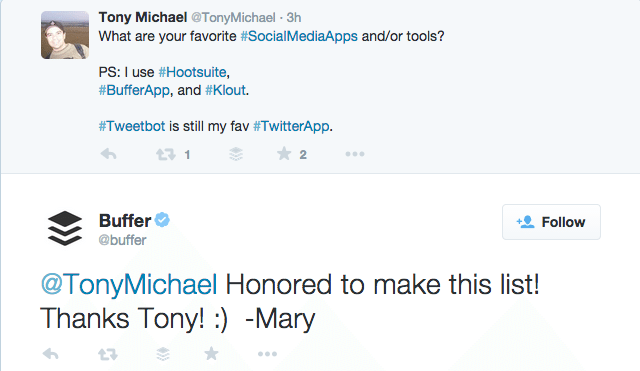
Since Twitter is a primary way for our customers to talk to us and ask questions, we use the tool Sparkcentral to funnel in and answer all @ messages, and this handy tools automatically appends our names with each tweet we send out.
For the other social networks like Facebook, Google+ and LinkedIn, a small team of us do daily “drive-bys,” where we schedule a block of time each day to visit your social media profiles. During this time, we simply try to remember to sign our names as we drop by and talk with our community.

Another handy tip is to consider how you can add a human touch to your social media bios. You might think about mentioning the names of the team members who’ll be posting from the account, or linking out to a Twitter list with all your team members on it, or even use a picture of your team as your cover photo or avatar.
Delegate by shifts or networks
One of the most common issues that arise when working with a social media team is figuring out who is going to do what, when, without stepping on one another’s toes. In other words, “Are you going to respond to that message, or should I?”
There are a few different ways to create some structure here to help everyone work more efficiently. Since it’s not practical for one person to be “on” at all times, you might consider trying a shift system, creating a general schedule of times when team members will oversee the brand’s social presence. Especially if you normally have a high volume of messages to respond to, this makes sure that social media responsibilities are generally covered.
Another way to divide out the responsibilities is by which networks you and your teammates are most interested in. I enjoy hanging out on Google+, so I probably make more frequent visits to that network, while other teammates dig Facebook a bit more. Playing to each team member’s passions and strengths could be a great option for maximizing efficiency and creating more fun on your team, too.
As new social media networks pop up, you can also designate team members to dig into them and do some experimenting so you’re always in the know about the next new thing.
Use tools to make collaboration easier
Fortunately, there are many tools out there that help organize social media teams.
Larger teams with a bigger budget might opt for all-in-one solution, and smaller teams might want to go the piece-by-piece route.
Some great categories to think on when looking for social media tools for teams might be: listening, communicating, scheduling, responding and analyzing.
This awesome slide deck by Kevin Mullett does such a good job and covers so many tools it could be a great place to start in all these categories:
For even more tools, our post on the 61 best social media tools for small businesses might be a great resource!
Give everyone the right access
If we might focus on a particular category of tools for a moment, we’ve found that using a social media scheduling tool allows teams to be significantly more efficient when posting to social media together.
We rely on Buffer’s own social media scheduling and team member functionality to add posts into our social media accounts—if you’re a Buffer customer with either an Awesome account or a Business account, you can to add team members to your account, which is really handy to keep everyone on the same page. And there are lots of other great options as well, including SproutSocial and Hootsuite.
One thing you might want to look for in your scheduling tool is the ability to add team members at various levels of access.
With our Business plans, you can invite many team members to any of your social profiles, depending on which profiles you want them to have access to. as either a Manager or a Contributor.
- A Manager can add updates to your Buffer account just like you can—they get added directly to your queue. They also have access to change your posting schedule.
- A Contributor has more limited access. They can add posts to a profile, but the post won’t be added to the queue until you approve it.
In talking to to our customers, we’ve found that this arrangement allows everyone the right amount of access and keeps running smoothly.
Have you ever used social media as part of a team? What are your best tips on making it work?
Icon image via The Noun Project
Try Buffer for free
190,000+ creators, small businesses, and marketers use Buffer to grow their audiences every month.



